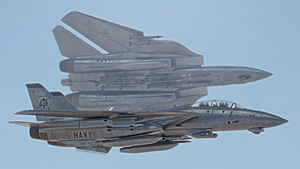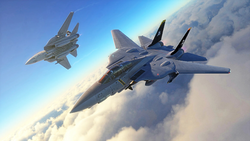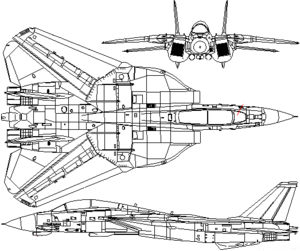Gruening F5M Lynx
| Gruening F5M Lynx | |
|---|---|

| |
| A pair of Meridonian Navy F5M6s of the High Spades conducting an overhead break at MNAS Marin Bay. | |
| Role | Air superiority fighter Multirole fighter |
| National origin | |
| Manufacturer | Gruening Defense Aerospace |
| First flight | 14 August 1970 |
| Introduction | 2 February 1974 |
| Status | In active service |
| Primary user | |
| Produced | 1969-present |
| Number built | 1,340 |
| Unit cost |
86.2 million MD (F5M7)
|
The Gruening F5M Lynx is a Meridonian carrier-capable, supersonic, twin engine, two seat, twin tail, variable sweep jet fighter built by Gruening Defense Aerospace. Originally designed for the Meridonian Navy to supplement and eventually replace the F4M Spectre in an air superiority fighter and interceptor role, it has been significantly developed and upgraded since its initial introduction to compose a major part of the tactical aircraft of both the Navy and the Air Forces, where it has been made capable of multirole missions.
Originally designed and optimized for long-range air to air interception of cruise missiles, bombers, and fighter aircraft, a need for long-range strike capabilities on naval aircraft became apparent, which saw later variants upgraded to become capable of precision bombing and reconnaissance via the Tactical Aircraft Navigation and Designation Module (TANDEM) pod. Following the collapse of the Air Force's Air Supremacy Initiative in the 1980s, the F5M was introduced as an interim solution to fill a gap in the air superiority field. Collaboration with the Navy and Air Forces in the 90s saw the introduction of the "Super Lynx", an enhanced design featuring leading edge extensions, integrated targeting and navigation systems, enhanced avionics and airframe construction, and a substantial enhancement in its mission profile with the ability to launch standoff air-to-ground munitions.
Currently, it serves as one of the mainline fighter aircraft of both services alongside the F6M2 Wasp, where it remains ideally suited for air combat missions. Built around the MUA-55 Phoenix long-range air-to-air missile as its primary armament, it remains one of the most potent long-range interceptors in service, though it has been upgraded to be able to field the MUA-120 CAIMS alongside the Wasp.
Development
Design
The F5M was designed based both on experience flying the F4M Spectre as a naval fighter, and on perceived needs of the carrier air wing in conducting force projection and self-defense operations. Seeing the threat of missile-armed bomber flights as an emerging threat towards the carrier group, the F5M was designed with long range and an air-to-air focus in mind while ground attack missions would be relegated to the F4, a role in which it had proved itself more than capable of performing. Like the F4M, the F5M was designed around a two-crew design with a pilot and radar intercept officer deemed better able to manage air intercepts.
A number of emerging technologies were included in its design, chief among those its variable geometry wings, which move forward for slower flight and move rearward for faster supersonic flight. It included a number of innovative control surfaces to improve its low-speed handling, which was necessary for carrier operations. Originally it was powered by a pair Altern MG-410 afterburning turbofan engines, which proved to be prone to compressor stall incidents at high angles of attack, and was later replaced by Hollon FT80 engines, which provided a substantial increase in both reliability and performance. Both engines are supplied with rectangular intakes equipped with movable ramps, bleed doors and other such functions. Landing gear is provided in a tricycle arrangement, and is reinforced for carrier landings.
The Lynx's weapons system was based around the utilization of the TAI-81 X band pulse-doppler radar, the first in use capable of launching using track while scan; and the MUA-55 Phoenix missile, a very long range air to air missile intended for intercepting targets at ranges in excess of 100 nautical miles. Utilizing the Phoenix for long-range intercepts and the MUA-7 Falcon for escort and air intercept missions. From the outset it was armed with the Mark 40 20mm cannon in a nose mount with 600 rounds of ammunition. The Lynx carries a radar warning receiver, chaff, flare, and models from the F5M4 and later are integrated with electronics countermeasures systems to defend against incoming missiles.
The Lynx featured pioneering developments in pilot interface in Meridonian fighter craft, including the first multi-function HUD, hands-on throttle and stick (HOTAS), and early multifunction displays, features which would prove instrumental in the design of later combat aircraft.
Lynx models from the F5M6 and later improve vastly upon the original design of the base model F5Ms (F5M through F5M5). The F5M6 introduced leading-edge extensions (LEX) to the wing root, enhanced visibility cockpit glass, full multifunction glass flight displays, integrated NAV/attack FLIR pods, and HMD integration, as well as allowing for the carrying of standoff weaponry including cruise, anti-satellite, and anti-ship missiles. The so-called "Super Lynx" upgrade vastly improved performance in nearly all aspects over the airframe. F5M7 upgrades, first fielded by the Air Force, feature a full glass display replacing all 'steam gauge' instruments.
Operational History

The F5M entered frontline service with the Meridonian Navy in early 1974, equipping units from 8 Carrier Air Group aboard the carrier Anerca- specifically, 35 Naval Fighter Squadron.
Following the collapse of the Air Forces' Air Supremacy Initiative in 1977, Gruening received a contract to massively upscale production to fill the capability gap for Air Forces units. The contract led directly to Gruening abandoning civilian sector development as it shifted its efforts entirely to military production of the Lynx, and for a time briefly became the largest single employer in its home Mahine Territory as it opened plants in Kohaku and TBD to support its Marin Bay operation. The first Air Forces unit to be equipped with Lynxes was 97 Tactical Fighter Squadron of Tactical Fighter Wing 74 in July of 1978.
Fleet F5M models were well-liked by pilots for their high thrust-to-weight ratios, endurance and range, and payload capacity. Issues with low-speed handling were apparent, however, as the plane was prone to difficult-to-recover flatspins at high yaw/high angle of attack scenarios, and the Altern MG-410 engines that equipped fleet models were prone to compressor stalls at high angles of attack. Maintenance personel found dealing with Lynx models cumbersome due to the complexity of its moving wing and wing vane systems. Some of the issues of early models were addressed in the F5M2 upgrade, however these models were mostly delivered to the Air Forces with the exception of two squadron's worth of planes being delivered to the Navy.
Navy F5Ms regularly conducted intercepts of Korean, Kaskaidan, Aureumterran and other aircraft sent to probe naval formations in the Marinan and Anagonian oceans. The retirement of carrier-based bomber platforms and the sunsetting of Chevalier-based photograph reconnaissance platform also saw the shifting of the photo reconnaissance duties of these aircraft onto fleet Lynxes, which were equipped with specially developed Aircraft Reconnaissance Capture Apparatus (ARCA) pods. The size of the ARCA pod required specialized modifications to aircraft to be able to carry them. Of an airwing's two Lynx squadrons, one was equipped with three ARCA capable aircraft. F5M5 and later models came equipped standard with these modifications, allowing flexibility in the employment of the ARCA pod until its sunsetting in 2010 with the advent of more capable and miniaturized targeting pods and other sensors systems such as UAVs.
Variants
- F5M
- Initial operational variant, first supplied to the Meridonian Navy in 1974. As initially supplied, it was almost purely an interceptor and air superiority aircraft, with marginal ground strike capability added through unguided bombs and rockets only. It was powered by Altern MG-410 afterburning turbofans, which proved unreliable and prone to compressor stalls especially at high AOAs. All F5M models were upgraded to F5M2 standard by 1983.
- F5M2
- Upgraded variant of the initial F5M2 variant addressing numerous concerns by the Navy and adding operational requirements for use by the Air Force. Wing vanes mounted in the glove box were permanently removed, and the addition of a second CRT display for navigation was included. Integration with civilian navigational sources including VOR and ILS were integrated for use, including a HUD approach mode. Automatic Carrier Landing System (ACLS) capability was added to this model. A total of 103 F5Ms were upgraded, and an additional 242 were produced to F5M2 standard.
- F5M3
- Upgrade program conducted in the mid-late 1980s, its primary improvement was replacing the unreliable Altern MG-410 engines with Hollon FT80s, which themselves were a product of the failed Air Supremacy Initiative. Performance increases were substantial, allowing even a fully-loaded fighter to take off without the use of afterburner, a feat unmatched by any other model of naval fighter before or since. Integration was added for the TANDEM NAVLFIR system, including the employment of laser-guided bombs.
- F5M4
- The F5M4 was an enhancement project designed to cover perceived gaps in employment capabilities. It was equipped with an enhanced TA-902E radar which mitigated the previous TAI-81's shortfalls to clutter detection, processing speed, and jamming capabilities, and included integration of an air-to-ground radar. New cockpit displays, including the first multifunction displays and an enhanced heads-up display, were added. The F5M4 was also integrated with an inbuilt ECM jammer and provided for the employment of GPS-guided bombs utilizing the TANDEM II pod. Deliveries began in 1992 and concluded in 1999.
- F5M5
- Primarily an enhancement program to upgrade F5M2 and F5M3 models to current standards in the mid 90s to early 2000s, the F5M5 label was also issued to upgraded F5M4s, to which the modifications were primarily software-related. The F5M5 included integration of a host of new weapons systems, including the MUA-120 CAIMS, MUB-65, and CUS-154 SOGW.
- F5M6
- The F5M6, or "Super Lynx", was a comprehensive re-drawing and enhancement program of the base airframe first produced in 1998. The F5M6 introduced a wide range of new upgrades to the airframe design. Equipped with the enhanced Hollon FT80E engines that provided additional fuel efficiency over the base model FT80s, the F5M6's efficiency and handling was also increased by redesigned leading edges, as well as leading edge extensions and new control surfaces. The F5M6 also introduced an inbuilt auxiliary power unit (APU) which removed reliance on ground facilities for aircraft startup. The F5M6 integrated a fly-by-wire system, a further enhanced TA-910 radar, integrated NAV/attack FLIR, full multifunctional displays for both pilot and RIO, redesigned cockpit glass, integration for helmet-mounted cuing systems, integration of stand off weaponry including anti-shipping, cruise missile and anti-satellite weaponry. Deliveries began in 1999 to the Navy and the Air Force in 2000, and deliveries were completed in 2014.
- F5M7
First fielded by the Air Force in 2020, the F5M7 is a modernization program that saw further flight control enhancements, including a full-panel multifunctional display for the pilot and RIO, as well as the redesign of some airframe components to decrease weight, increase performance, or increase longevity. The Navy received its first batch of upgraded F5M7 models in 2021.
Operators
Current Operators
 Meridon- 662 in service of F5M6 and F5M7 variants across both Air Forces and Navy.
Meridon- 662 in service of F5M6 and F5M7 variants across both Air Forces and Navy. Svetvostok- 80 in service of F5M6 variant with the Svetvostok Navy.
Svetvostok- 80 in service of F5M6 variant with the Svetvostok Navy. Kozakura- 270 F5M4s variants in service with the Kozakuran Air Forces. Slated to upgraded to the F5M7 variant.
Kozakura- 270 F5M4s variants in service with the Kozakuran Air Forces. Slated to upgraded to the F5M7 variant.
Former Operators
Joseon- A total of 240 F5M2 aircraft were operated, and the last aircraft retired in 2023. 64 are still listed as reserve aircraft.
Specifications (F5M6)
General Characteristics
- Crew: 2
- Length: 62 ft 9 in (19.13m)
- Wingspan: 64 ft 1.5 in (19.545 m)
- Swept wingspan: 38 ft 2.5 in (11.646 m) swept
- Height: 16 ft (4.9 m)
- Wing Area: 565 sq ft (52.5 m2) wings only
- Empty Weight: 45,624 lb (20,694 kg)
- Max Takeoff Weight: 76,820 lb (34,844 kg)
- Powerplant: 2 × Hollon FT80E afterburning turbofans
- Fuel Capacity: 17,000lb internal, 2x optional 267gal (1,756lb/797kg) external tanks
Performance
- Maximum Speed: Mach 2.41 (2,975 km/h, 1,849 mph) at altitude
- Service Ceiling: 55,000 ft (16,764 m) +
- Rate of Climb: 45,000 ft/min plus (230 m/s)
- Wing Loading: 96 lb/sq ft (470 kg/m2)
- Thrust/Weight: 1.14, clean configuration, 50*
Armament
- Guns: 1 × Mark 40 25mm cannon with 600 rounds
- Payload: 10 hardpoints total: 4 between engine fairing, 2 under engine nacelle, 2 per wing glove (1 wing glove per wing) with capacity of 15,000lbs (6,803 kg) of munition to carry the following:



